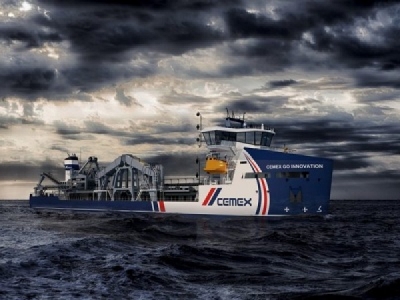
Posted on July 17, 2018
Damen Shipyards Group has begun construction of the first Marine Aggregate Dredger (MAD), which is designed to extract sand and gravel from the seabed at depths to 55 m, including in the challenging conditions of the North Sea.
The vessel, which is being built at Damen Shipyards Galati in Romania, is for Cemex UK Marine Ltd.
The life expectancy of such a vessel is up to 30 years, so it was important to Cemex that Damen develop them a vessel that was future-proof. The result is a vessel with an advanced focus on safety, performance and sustainability that will ensure its relevance in the years to come. The innovation of the MAD extends to the dredging system that Damen Dredging Equipment has recently started work on in Nijkerk, the Netherlands.
The ship will be powered by Wärtsilä 6L26 diesel engines, which offer 340 kW of output per cylinder and have a bore and stroke of 260 X 320 mm. Wärtsilä said the 26 engine was developed in response to a need in the market for an engine in the 260 mm cylinder bore class. The shortest and lowest engine in its class, the Wärtsilä 26 requires minimal space in the engine room, according to the company.
Cemex asked Damen to develop a system with no inboard dredge pipework, something which has never been done on a vessel of this size before, according to Damen. The thinking behind this was to avoid the possibility of the abrasive dredged material creating wear holes in the inboard dredge pipework on board making it a safer and easier maintenance-friendly system.
“This initial design from Damen Dredging Equipment, considerably reduces the risk of flooding. It has implications way beyond the obvious improvements in safety, not only for the crew on board but also for the maintenance staff, as there will be a reduced requirement for expensive wear parts as well as fast, practical replacement,” said Mark Williams, Cemex UK fleet engineering manager.
Reduced maintenance is a common theme to be found throughout the dredging system design, said Frank de Hoogh, DDE design and proposal engineer.
“The modular nature of the dredging system takes care of this. Where maintenance was previously a significant undertaking, it can now be conducted with just the on-board service crane, significantly lowering maintenance requirements and increasing uptime.”
An example of this modularity at work is the screening installation. This is fixed, as opposed to the typical rotating screen towers more commonly used. In addition to being more maintenance friendly, the screening area features an increased capacity courtesy of a larger surface area.
Another element is the dry unloader machine that Damen has developed along with Cemex and manufacturer PLM. As a concept, Damen has selected the proven principle of a grab unloader, however a lot of work has gone into optimising the design. For example all electronics on the machine are rated IP68 for long term reliability. Another example is the design of the grab which is optimized to maximize efficiency of each discharge cycle.
“Such a system already exists in principle, but this model represents the next step – the next generation – in dry unloading technology.”
Ultimately, Frank says, the MAD benefits from Damen’s role of vessel integrator. “We are responsible not only for the design and build of the vessel, but also for the design and delivery of all on board equipment and its integration with the vessel. This ensures the predictable, reliable performance of the end product.”
Source: Diesel & Gas Turbine Worldwide





